Ever record an episode and wonder why your voice sounds crisp one day, then hollow the next?
It’s probably not your mic. It’s the polar pattern.
If you’ve been asking what microphone polar patterns are and why they mess with your sound, you’re in the right place.
Most people skip this part when they set up their mic. But if you want clean, studio-level audio, this is the bit that matters.
I’ve recorded in cafes, studios, bedrooms, and on the go. I’ve tested every mic style out there. And what makes the biggest difference? Picking the right polar pattern for your setup.
This guide keeps it simple. I’ll walk you through what each polar pattern does, when to use it, and how to read those weird diagrams.
By the end, you’ll know exactly how to sound sharp every time you hit record.
What Are Microphone Polar Patterns?
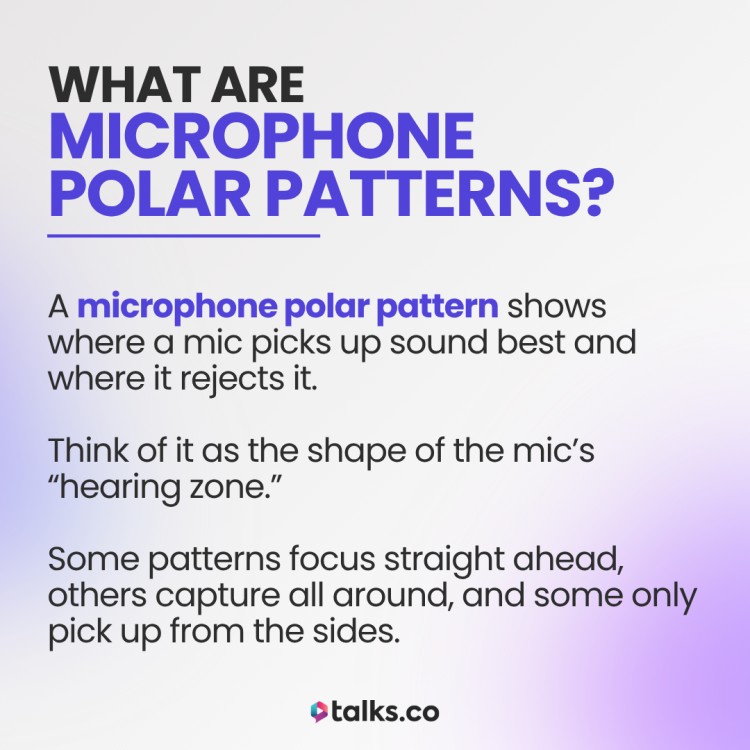
A microphone polar pattern shows where a mic picks up sound best and where it rejects it.
Think of it as the shape of the mic’s “hearing zone.” Some patterns focus straight ahead, others capture all around, and some only pick up from the sides.
Choosing the right pattern can be the difference between crisp audio and a messy, echo-filled recording. If you’ve ever asked, “What is a polar pattern?”, this is where it starts.
Microphone polar patterns explained
Polar patterns visually represent how sensitive to sound your mic is from different directions. Imagine a spiderweb chart showing how much sound the mic picks up around it.
Here’s a quick look at the most common polar patterns and characteristics:
| Polar Pattern | Pickup Direction | Best For |
| Cardioid | Front only | Podcasts, vocals, solo voice |
| Omnidirectional | All directions | Group conversations, ambience |
| Bidirectional | Front and back | Interviews (face-to-face) |
| Subcardioid | Mostly front, some sides | Natural sound with some room ambience |
| Supercardioid | Narrow front, some rear | Film, stage mics, noisy spaces |
| Hypercardioid | Very narrow front, some rear | Film sets, live shows, loud environments |
| Shotgun | Very focused front pickup | Video, boom mics, outdoor shooting |
This is also where different microphone types and different polar patterns come into play. For example, most dynamic mics are cardioid microphones, while many lavalier mics are omnidirectional microphones.
For more on mic types and options, see our best budget microphones guide.
What are polar patterns in microphones?
Polar patterns tell you how a mic reacts to sound from different angles. A cardioid microphone will ignore sounds behind it. An omni mic won’t.
If you’ve ever looked at a mic spec sheet and seen a spiderweb-looking graph, that’s the polar pattern diagram. Here’s how to read one:
- The center dot is the mic’s capsule.
- The lines show how sensitive it is at different angles.
- The outer ring is maximum sensitivity.
For example, in a cardioid diagram, the front arc (0 degrees) reaches the edge, but the back (180 degrees) barely shows, meaning it won’t pick up much behind it or reject sound well from there.
This makes it easier to understand how directional polar pattern a mic is before you buy or use it.
Understanding microphone polar patterns
Think of polar patterns as a mic’s personality. They decide how much room noise gets in, who gets heard clearly, and what gets left out.
For example:
- A podcaster in a home office might want cardioid to block echo from the walls.
- A fitness coach filming in a big gym might go lavalier omni so the mic picks up everything evenly.
- A videographer outdoors might rely on a shotgun mic to isolate voices from wind and crowd noise.
Polar patterns also affect frequency response. Some mics change their tone depending on where you speak into them. Bass response often varies, especially in cardioid mics that sound brighter from the front of the microphone than from the sides.
If you want to get your podcast room setup right for the best sound, see our podcast room setup guide.
7 Types of Microphone Polar Patterns
Your mic’s polar pattern determines how it picks up sound from the front, sides, rear, or all around. It’s what shapes the directionality of your audio.
Each microphone polar pattern serves a different purpose, depending on what you’re recording and where you’re doing it.
1. Omnidirectional polar pattern
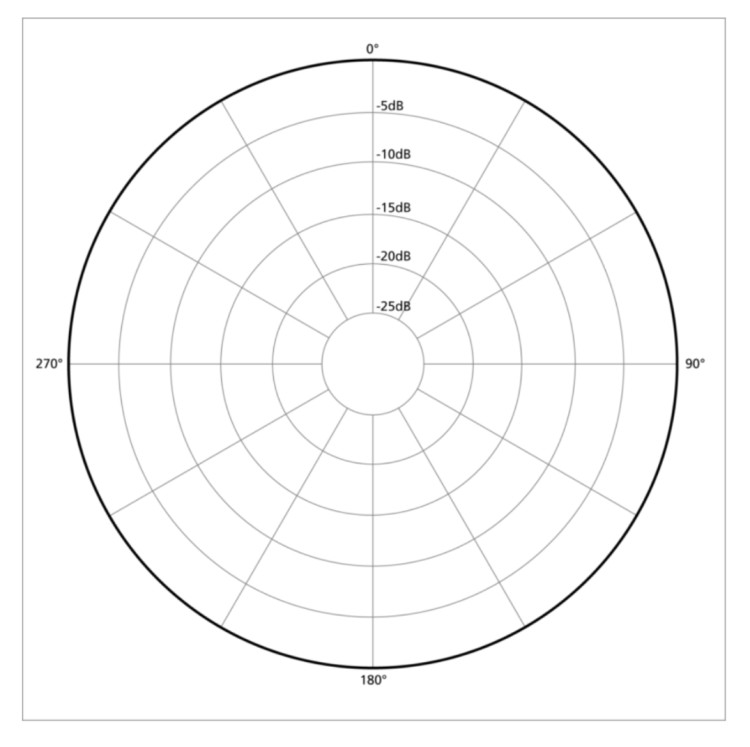
Picks up sound equally from all directions. Think of the mic sitting in the middle of a bubble, catching everything around it.
- Best for: Group discussions, room tone, or when you don’t want to worry about mic direction.
- Example: Rode SmartLav+ lapel mic.
- Why it works: You don’t have to aim it; it catches every sound source.
Heads-up: No noise rejection, so it picks up every cough, shuffle, or background hum.
2. Subcardioid polar pattern
Picks up mostly from the front but allows some sound from the sides, wider than cardioid but narrower than omnidirectional.
- Best for: When you want a natural sound but still want to focus on the speaker.
- Real-world example: AKG C414 (some models have this mode).
- Why it works: Lets in a bit of room sound to avoid a “too dry” voice but still reduces noise behind.
Tip: Good for recording in rooms with decent acoustics where a bit of natural reverb helps.
3. Cardioid polar pattern
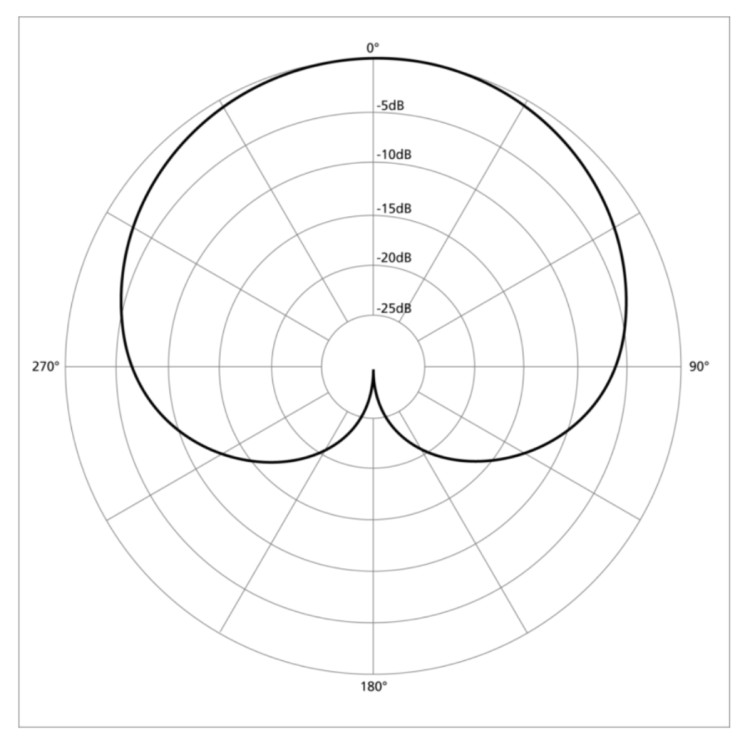
Picks up sound mostly from the front in a heart-shaped pickup pattern. It reduces noise from behind the mic, like fans, clicking, or background chatter.
- Best for: Solo recordings (e.g., podcasts, livestreams, voiceovers).
- Real-world example: Blue Yeti mic in cardioid mode or the Shure MV7.
- Why it works: Blocks out room noise and focuses on your voice. Ideal if you’re speaking directly in the front of the mic.
Simple tip: If you turn your head away or move too far off-centre (“off-axis”), your voice will lose clarity.
4. Supercardioid polar pattern
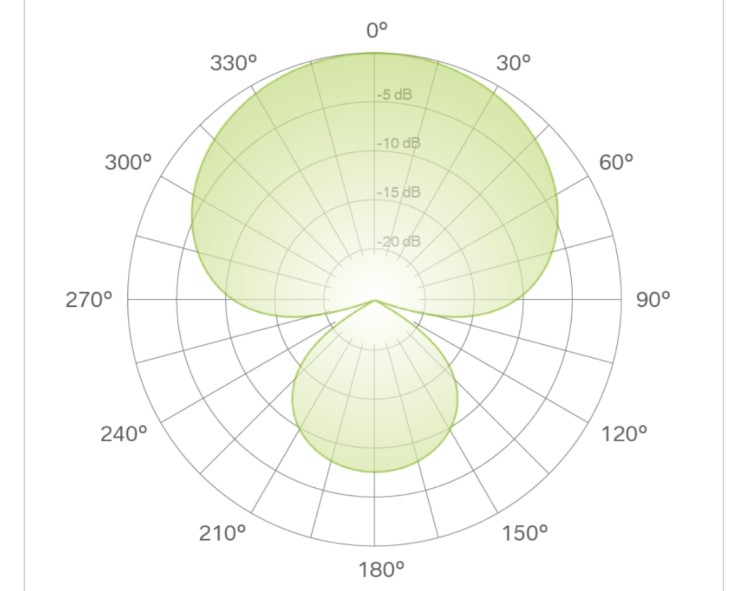
Narrower focus than cardioid. Picks up a tighter area in front, but also grabs a bit from directly behind.
- Best for: Studio sessions, controlled settings, or loud environments.
- Example: Sennheiser e935 or Rode NTG2 shotgun (in close setups).
- Why it works: Helps isolate your voice even more. Useful when you’re in a room with echo or competing noise.
Note: Stay in front of the mic or your voice will sound weaker.
5. Hypercardioid polar pattern
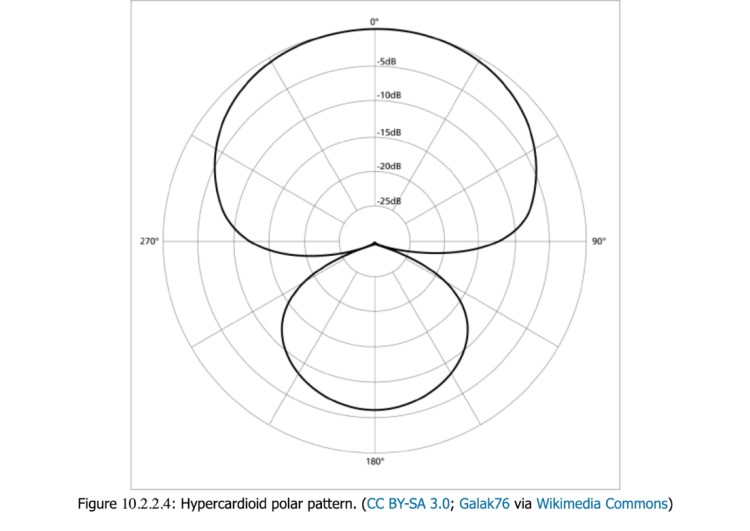
Even tighter than supercardioid, with a very narrow front pickup and some pickup behind.
- Best for: Film sets, live shows, and loud environments.
- Real-world example: Shure SM7B (often considered hypercardioid-like).
- Why it works: Great at isolating sound in noisy places.
Simple tip: Keep your head steady and on-axis for the best sound.
6. Bidirectional (Figure-8) polar pattern
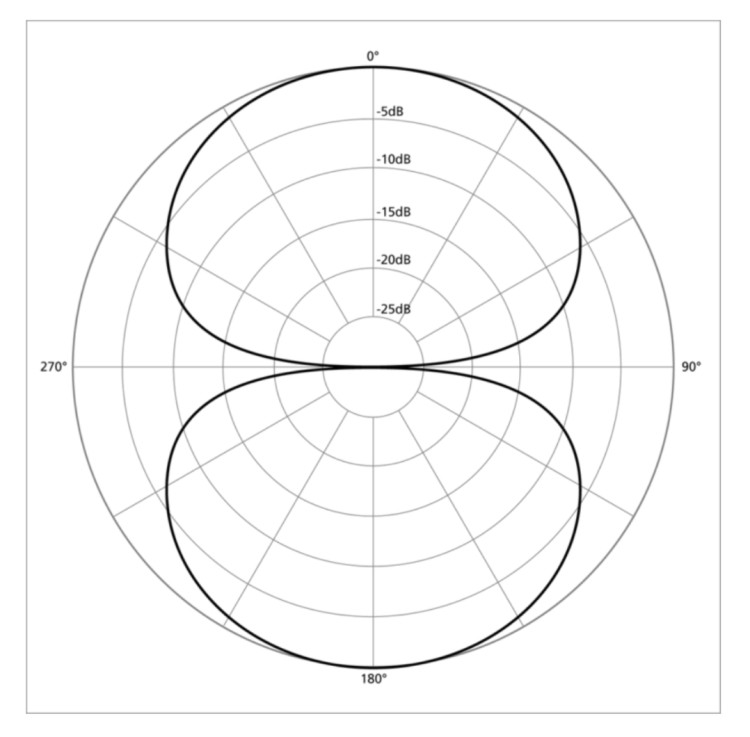
Captures audio from the front and back, but blocks out sound from the sides. Imagine two circles: one in front, one behind.
- Best for: Face-to-face interviews with one mic.
- Real-world example: Audio-Technica AT4050 in figure-8 mode.
- Why it works: Perfect for two speakers sharing one mic across a table.
Simple tip: Side noises (like a clinking glass or passing car) get blocked, but make sure both speakers stay aligned with the front and back.
7. Shotgun polar pattern
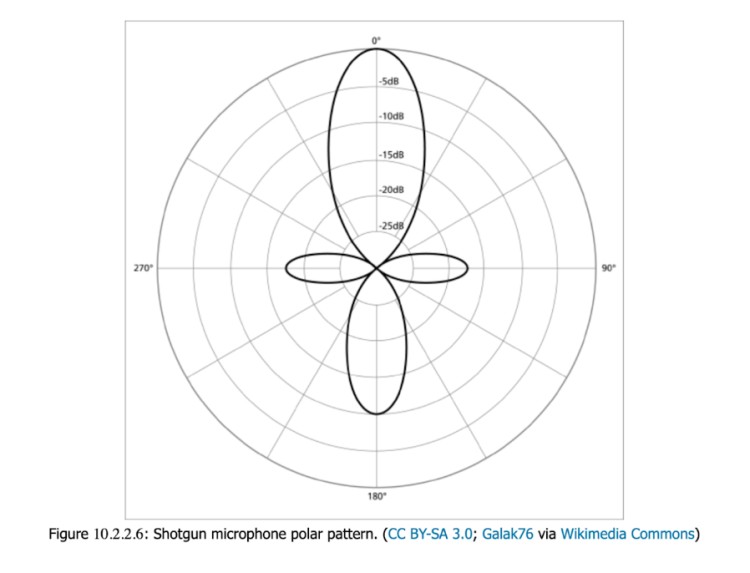
Extremely directional microphone. Picks up sound from a narrow path in front and blocks nearly everything else. Often long and tube-shaped.
- Best for: Video shoots, outdoor scenes, or far-away subjects.
- Real-world example: Rode NTG5 or Sennheiser MKE 600.
- Why it works: You can point it at a speaker from several feet away and still get clean audio even in noisy places.
Caution: If your subject moves off-axis, the audio will drop quickly.
If you want to bundle your gear right, check our podcast equipment bundle guide.
What Is a Microphone Polar Patterns Chart?
Think of a polar pattern chart as a map showing exactly where your mic listens and where it shuts out noise. Knowing how to read it means no more guessing where to point your mic or where to sit.
Early microphones picked up sound from all directions. Then, in the 1930s, Shure engineer Ben Bauer created the first single-element cardioid mic, changing how we understand mic directionality.
You don’t need special software to find these charts. They usually come with your mic or are easy to find online.
How to read a polar pattern diagram
Each chart shows your mic’s sensitivity around a circle. The mic sits in the center, pointing straight ahead (zero on the chart). Here’s how to read it:
- Find the front: Zero means where the mic points. That’s where it hears best, unless it’s an omnidirectional mic that listens all around.
Look at the shape: The curve tells the story. Cardioid looks like a heart, omni is a full circle, figure-eight looks like… well, an 8, and shotgun is a narrow oval. - See how far it reaches: The longer the line from the center, the better the mic hears that way.
- Spot the quiet spots: Flat or dipped areas show where the mic blocks sound. Perfect for keeping out noisy fans or busy streets.
- Match it to your setup: Use front-focused patterns when you’re recording solo, front and back for interviews, and side-blocking patterns when the room’s noisy.
Most common polar patterns and characteristics
Let’s look at real situations you might face and which patterns suit them best:
- Solo podcast or voiceover: Cardioid is your go-to. Blocks room noise and focuses on your voice.
- Group chat or panel: Omnidirectional works well, capturing everyone naturally.
- Face-to-face interview: Bidirectional lets you use one mic for two speakers.
- Noisy or echoey room: Supercardioid or hypercardioid helps isolate your voice.
- Outdoor video: Shotgun cuts through wind and crowd noise for cleaner audio.
Microphone types and polar patterns
Mic types usually lean toward certain polar patterns:
- Dynamic mics: Mostly cardioid. Good for vocals, loud sources, noisy spaces.
- Condenser mics: Often cardioid or omni. Condenser microphones are great for studio and detailed sound.
- Lavalier (lapel) mics: Usually omnidirectional to capture natural sound without aiming.
- Shotgun mics: Specialized supercardioid designed for directional video work.
Knowing your mic type helps you pick or switch polar patterns without buying new gear.
What is frequency response in relation to microphone polar patterns?
Frequency response describes how your mic captures different sound frequencies (bass, mids, and highs) depending on the direction of the sound source.
Because polar patterns change how much sound is picked up from various angles, they also affect the tonal balance of your recording. For instance, with cardioid mics, speaking on-axis (right in front) usually delivers a fuller, richer sound, while speaking off-axis (to the side) can make your voice seem thinner or duller.
Understanding this helps you find the best position to deliver clear, natural audio with consistent tone, not just volume.
Need help setting up your recording? Check out our how to record a podcast guide.
Which Microphone Polar Pattern Should I Use?
Here’s a quick checklist to find your ideal polar pattern fast:
☐ Test your mic’s patterns: Record yourself with each available pattern in your usual setup.
☐ Listen for clarity and noise: Pick the pattern that blocks background noise and sounds natural.
☐ Check off-axis sound: Move or turn your head slightly to see how each pattern holds up.
☐ Match your mic type: Use cardioid with dynamic mics, omni with lavaliers when possible.
☐ Avoid common traps: Don’t assume more directional is always better. Sometimes omni or subcardioid suits your room better.
☐ Adapt without new gear: Switch patterns or adjust position instead of buying new mics when changing formats.
Testing saves money and hassle, helping you get great sound every time.
Get Your Sound Right. Get Your Guests Right.
Getting your head around microphone polar patterns means you’re not just turning up the volume. You’re making your voice sound sharp and clear every time. The right pattern cuts out distractions and puts your words front and center.
If you’re a podcast host, that clarity is key. But finding guests who actually fit your show can feel like another puzzle altogether.
That’s where Talks helps you out.
Create your free Talks profile, and you’ll connect with guests who bring fresh energy and stories that click with your vibe.
No more scrambling or settling for the wrong fit.
Ready to get your sound right and your guest list sorted? Sign up for free and start booking the kind of episodes your listeners will remember.
Create Your Free Talks Creator Profile Here



